NIEHS/NTP celebrates 20-year partnership with FDA
By Cindy Loose
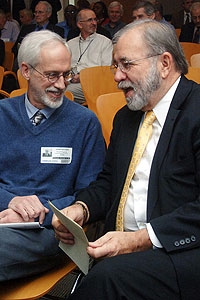
Bucher and Allaben enjoy a light moment during one of the breaks. (Photo courtesy of Cathy Brown)
A unique partnership between NIEHS and the U.S. Food and Drug Administration (FDA) has been so successful at protecting public health that countries around the world are seeking advice on how to implement a similar program, said NIEHS/NTP Director Linda Birnbaum, Ph.D., at a recent gathering celebrating the 20th anniversary of the collaboration.
Birnbaum was referring to the formal interagency agreement that was signed by both agencies in December 1992. The agreement makes it possible for NIEHS to provide support for toxicological studies on agents of public health concern that are conducted at the FDA (NCTR). Dozens of critical, complex studies carried out through this agreement have helped protect public health.
The National Toxicology Program (NTP) is an interagency program, headquartered at NIEHS, that coordinates and manages the efforts of the U.S. Department of Health and Human Services to understand the hazardous nature of chemicals to which the U.S. public is exposed. The interagency agreement between NIEHS and FDA is a critical mechanism by which these federal partners cooperatively work together to achieve these goals.
Milestones accomplished
At the anniversary ceremony Nov. 14 at FDA headquarters in Silver Spring, Md., NTP Associate Director John Bucher, Ph.D., provided some key examples of how the collaboration between the agencies has impacted public health. He mentioned one study, in particular, that has helped improve the safety and quality of seafood imported from overseas.
“The work we’ve done together has really made a difference,” said Jesse Goodman, M.D., FDA’s chief scientist. He noted that one of the earliest studies looked at fumonisin B1, a toxin produced by fungi that grow on many types of corn and other grains. Considered the definitive study on the carcinogenicity of the fungi, the data were used around the world to set allowable contaminant levels in grains used in both animal and human food products.
Coordinating through a committee of diverse partners can pose some challenges but, as Birnbaum noted, “The interagency agreement allows us to work together to develop common approaches to solve real public health questions.”
Immediate practical applications
NTP Deputy Division Director for Science Nigel Walker, Ph.D., said studies take on a special dimension when you work with the people who need the data to make important regulatory decisions that can help protect lives.
“The public wants us to do the right thing, and this agreement allows us to work and spend wisely for public health,” Walker said.
“Enormous efforts on the part of many people were needed to make the interagency agreement a success,” said William Allaben, Ph.D., an early leader of NCTR. He singled out Connie Weis, who has worked at NCTR since 1997, and has been a program manager there since 2003. Weis, who is retiring from the FDA, was honored at the ceremony with a plaque. “I don’t know what I would have done without her in my corner,” said Allaben, who also thanked Birnbaum for “embracing us.”
NTP toxicological studies carried out at NCTR have led to regulations of a number of ingredients in dietary supplements, animal feed, cosmetics, and in both human and veterinary pharmaceuticals. Potential health effects from exposure to bisphenol A, or BPA, is among the many studies currently ongoing.
The collaboration has advanced science and taken advantage of new scientific tools in state-of-the-art labs, to take on new challenges posed by emerging sciences. For example, in 2010, the FDA/NCTR and NIEHS/NTP, among others, collaborated to develop a Nanotechnology Core Facility to study potential health effects from rapidly developing nano-related products.
As Birnbaum concluded in her remarks, “The interagency agreement has produced 20 years of productive collaboration in science and research, and let’s hope for many more.”
(Cindy Loose is a contract writer with the NIEHS office in Bethesda, Md.)
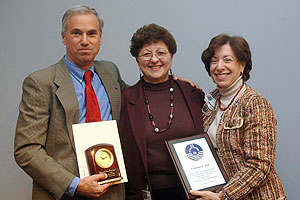
Weis, center, accepts her plaque for many years of dedicated service to the FDA and NTP from Goodman, left, and Birnbaum. (Photo courtesy of Cathy Brown)
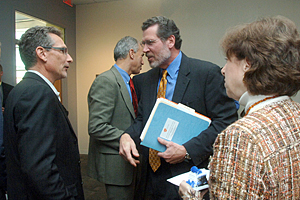
NCTR Director William Slikker Jr., Ph.D., center with folder, and Birnbaum, right, chat with attendees. (Photo courtesy of Cathy Brown)
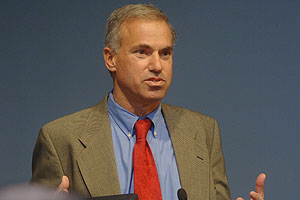
Goodman talked about the carcinogenicity of Fumonisin B1 in his remarks. (Photo courtesy of Cathy Brown)
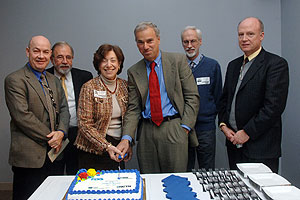
NIEHS and FDA leadership prepare to dig into a tasty-looking cake prepared for the celebration. From left to right are Walker, Allaben, Birnbaum, Goodman, Bucher, and Paul Howard, Ph.D., director of the Office of Scientific Coordination at NCTR and FDA project officer on the NCTR/NIEHS interagency agreement. (Photo courtesy of Cathy Brown)
"Birnbaum receives prominent EPA ..." - previous story ![]()
![]() next story - "NIEHS knocks it out ..."
next story - "NIEHS knocks it out ..."
December 2012 Cover Page


